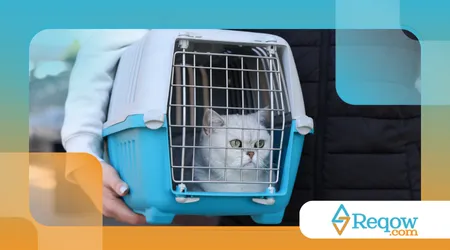Get your pet used to transportation: car, bus, and plane

The journey begins with the challenge of Get your pet used to transportation, whether it's a short car trip, a bus adventure, or an international flight.
Advertisements
Your furry companion deserves to explore the world alongside you.
Many owners avoid traveling or walking their four-legged friends due to stress.
However, with the right preparation, the experience can be enjoyable for everyone. The secret is to transform discomfort into familiarity.
Why Acclimatization is Crucial for Stress-Free Travel
Successful acclimation minimizes anxiety, preventing destructive behaviors or persistent fears.
Advertisements
Transporting a pet can be daunting for someone with no prior experience. The unknown can cause apprehension.
Your pet's well-being is our top priority in this specialized column. Traveling with peace of mind is a right for both of us. Gradual adaptation is the key to success.
Trying to force the situation only worsens the trauma and fear. Remember, patience and consistency are your best allies. A positive approach is essential.
The habituation process should be seen as fun and rewarding training, never as punishment. Your pet should associate the vehicle with good things.
The Beginning of the Journey: Getting Used to the Car
The car is usually the first mode of transportation your pet will experience. Start training with the vehicle stopped.
First, leave the carrier or seatbelt in the car for a while. Let your dog explore the smell and feel safe there.
Reward calmness with treats and favorite toys. Create an atmosphere of comfort.
Run the engine for short periods without moving. The vibration and noise of the engine are part of the experience.
Then, take very short walks, like walking around the block. Gradually increase the length of the walk, step by step.
If your dog, the Labrador Tobi, shows apprehension, start giving him treats in transport box at the bank.
After, just Close the car door for a minute. Gradually, he'll understand that the car isn't a threat.
Read more: Vaccination and deworming guide: what your pet needs at each stage of life
Using synthetic pheromones or chew toys can help relieve tension. Safety is non-negotiable; always use an appropriate car seat or harness.
Get your pet used to transportation Car training requires constant positive reinforcement. Remember, every pet has its own rhythm.

Urban Challenges: Buses and Other Public Transportation
Public transportation is noisy, crowded, and has more sudden movements. Preparation must be even more meticulous.
Check the rules of each bus company, which vary greatly throughout Brazil. The size and type of pet kennel (transport box) are crucial factors.
Start acclimation outside the bus, near the stops. Let them observe the movement and noise.
If permitted, travel during off-peak times. This reduces the stress of overcrowding.
Find out more: Paw Care Routine: Preventing Cracks and Wounds
Use the same carrier your dog already uses in the car. Familiarity with the carrier helps establish security.
The experience can be compared to that of an athlete preparing for a marathon. They don't run the 42km on the first day.
Acclimatization for Air Travel Getting your pet used to transportation
Traveling by plane is the most complex level and requires months of planning. The process Get your pet used to transportation air is long.
IATA (International Air Transport Association) establishes strict guidelines for the transportation of animals. Consult them.
The pet must be completely comfortable in the carrier, as it will spend long hours in it. kennel should be seen as a safe nest.
Approximately 80% of flight adaptation problems are linked to crate discomfort. Crate training is essential.
Look how interesting: How to Correct Excessive Barking in Dogs
According to ABEAR (Brazilian Association of Airlines), the number of pets transported on domestic and international flights grew by 15% in 2024. This growth shows the relevance of our discussion.
Ideally, your pet should sleep, eat, and play in the crate weeks in advance.
| Means of Transport | Acclimatization Focus | Common Legal Requirements |
| Car | Noise, vibration and space constraints | Use of seat belt/car seat and closed window |
| Bus | Movement of people, noise and weight limit | Kennel suitable and veterinary report |
| Plane | Prolonged stay in kennel and pressure | Microchip, Animal Transit Guide (GTA) and health certificate |
The administration of sedatives should be a decision exclusive from the veterinarian. Never medicate the animal yourself.
Luna, a Beagle, needed to fly to Europe.
Her guardian placed the carrier in her room for 2 months, feeding her there. She traveled safely because the kennel it was already his home.

The Guardian's Role: Emotional and Legal Security
You are your pet's safe haven. Stay calm, as your anxiety will be transmitted to them.
Make sure all vaccinations and health checkups are up to date. Documentation is just as important as training.
Federal Law 14.459/2022, for example, partially regulates the transportation of pets on public land transport. Stay up to date on the regulations.
Emotional safety is vital. Have you ever wondered if we're truly doing everything in our power to ensure their well-being on our travels? It's a valid question.
Get your pet used to transportation it is an act of love and responsibility.
Exploring the World Together Getting your pet used to transportation
There's no magic, but rather technique, dedication, and love. With proper planning and a step-by-step acclimation process, your pet will be ready.
In 2025, pet travel options are vast, and the rules are becoming increasingly clear. Seize the moment.
Get your pet used to transportation opens the doors to unforgettable adventures. Embrace the journey of discovery and live the best life with your faithful friend. Your next destination awaits you both!
Frequently Asked Questions
Why does my pet get carsick and how can I help?
Motion sickness is common and can be caused by stress or vehicle motion.
It helps to stay calm, use a seat belt to minimize excessive movement, and gradually accustom your pet to the car, starting with the vehicle stopped.
In persistent cases, consult your veterinarian about safe antiemetic medications for pets.
Can I take my pet on the bus without a carrier?
In most public transport companies in Brazil, the use of a rigid and safe transport box (kennel) with adequate ventilation is mandatory.
Additionally, the pet must fit within the company's pre-established weight and size limits, and many require a veterinary health certificate. An exception may be made for guide dogs.
Is it safe to sedate my pet for a long plane trip?
Sedation is generally discouraged by most veterinarians and airlines, especially for animals traveling in the hold.
This is because the sedative can interfere with your pet's ability to regulate body temperature and react to changes in pressure or noise.
The decision to sedate should always be discussed and prescribed by a veterinarian, weighing the risks and benefits.
How do I know if my pet is ready for a long trip?
Your pet is ready when he or she demonstrates calmness and acceptance within the kennel, associates the carrier or vehicle with positive reinforcement (treats, toys), and does not show intense signs of anxiety, such as tremors, excessive salivation, or constant vocalization, during simulations or short trips.
What documentation is essential for international air travel?
For international flights, you will need at least the International Veterinary Certificate (CVI) or Passport for Transit of Dogs and Cats, which replaces the CVI in some countries, in addition to the health certificate and proof of up-to-date vaccinations (especially rabies vaccinations).
It is crucial to check the specific import rules of the destination country well in advance.
